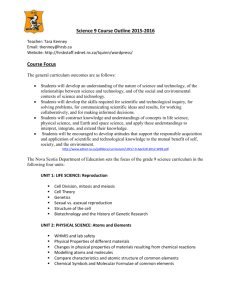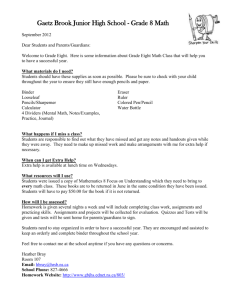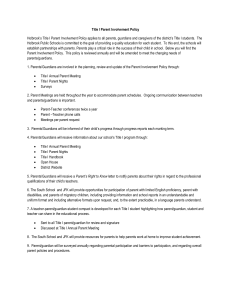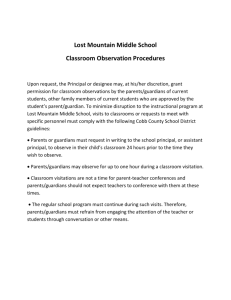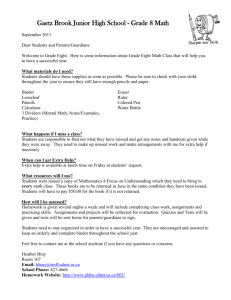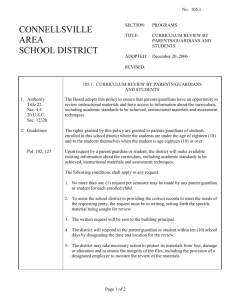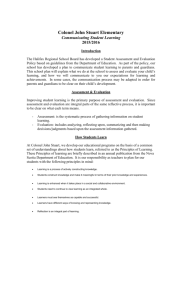Plan for Communicating Student Learning
advertisement
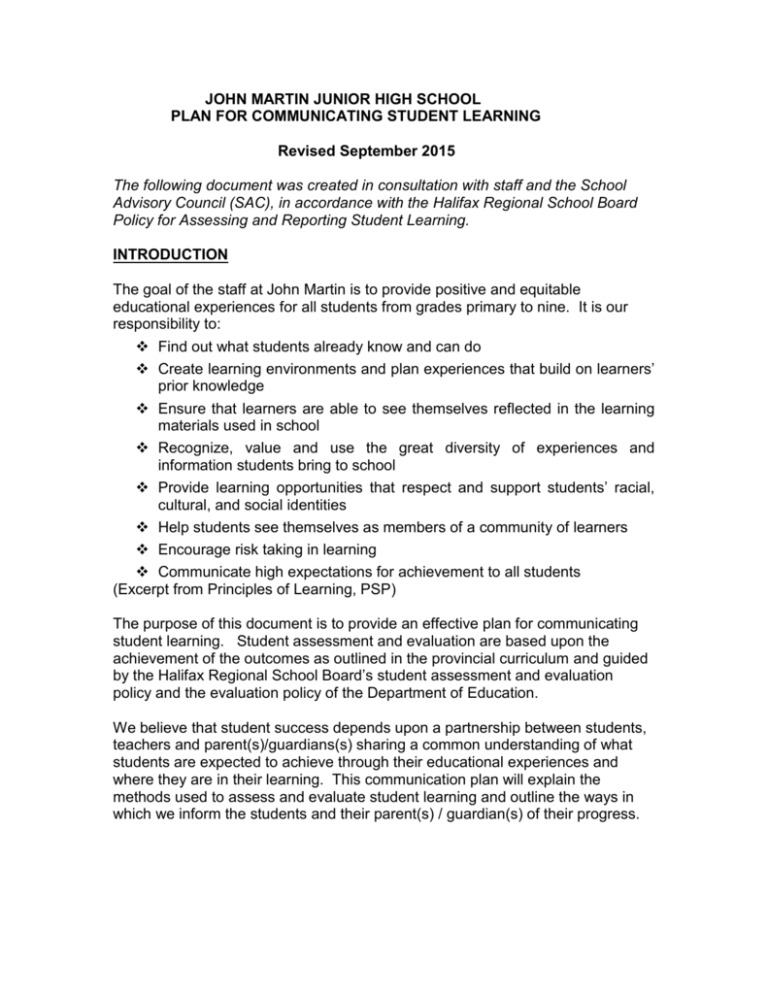
JOHN MARTIN JUNIOR HIGH SCHOOL PLAN FOR COMMUNICATING STUDENT LEARNING Revised September 2015 The following document was created in consultation with staff and the School Advisory Council (SAC), in accordance with the Halifax Regional School Board Policy for Assessing and Reporting Student Learning. INTRODUCTION The goal of the staff at John Martin is to provide positive and equitable educational experiences for all students from grades primary to nine. It is our responsibility to: Find out what students already know and can do Create learning environments and plan experiences that build on learners’ prior knowledge Ensure that learners are able to see themselves reflected in the learning materials used in school Recognize, value and use the great diversity of experiences and information students bring to school Provide learning opportunities that respect and support students’ racial, cultural, and social identities Help students see themselves as members of a community of learners Encourage risk taking in learning Communicate high expectations for achievement to all students (Excerpt from Principles of Learning, PSP) The purpose of this document is to provide an effective plan for communicating student learning. Student assessment and evaluation are based upon the achievement of the outcomes as outlined in the provincial curriculum and guided by the Halifax Regional School Board’s student assessment and evaluation policy and the evaluation policy of the Department of Education. We believe that student success depends upon a partnership between students, teachers and parent(s)/guardians(s) sharing a common understanding of what students are expected to achieve through their educational experiences and where they are in their learning. This communication plan will explain the methods used to assess and evaluate student learning and outline the ways in which we inform the students and their parent(s) / guardian(s) of their progress. STUDENT LEARNING The development of educational programs at John Martin is based on the Public Schools Program Document provided by the provincial Department of Education. Contained within this document are the goals of Public Education, the Learning Outcomes Framework and the Principles of Learning. The Outcomes Framework tells what the students will learn and the Principles tell how students learn. Each teacher is provided with curriculum guides that describe what students are expected to know and be able to do at various grade stages along the continuum of learning for each curriculum area. For each stage there are outcomes describing the knowledge and skills that demonstrate the level of ability in that stage. This set of expectations is referred to as the Learning Outcomes Framework. The learning outcomes are a reflection of six Essential Graduation Learnings, which are the expected skills, knowledge and attitude students should achieve by the time they graduate from High School. They include: Aesthetic expression Citizenship Communication Personal development Problem solving Technological competence Each teacher develops curriculum plans based upon the outcomes as outlined in the provincial documents. Curriculum plans include the outcomes to be covered, and the types of activities used in the delivery and assessment of the outcomes for the various subject areas. Teachers at John Martin are aware of the diverse learning styles and abilities of students. Curriculum is designed to ensure that all children are challenged at the appropriate level and thus can therefore experience meaningful academic success. HRSB’s Mission Providing a high quality education for every student every day (HRSB Strategic Plan 2013 – 2017) Continuous School Improvement (CSI) John Martin School Improvement Plan is focused on Literacy and Mathematics. Details of the plan can be found on our John Martin Website http://www.johnmartin.ednet.ns.ca/ HOW CHILDREN LEARN Educational programs at John Martin are based upon common understanding about how children learn as outlined in the Principles of Learning found in the Public Schools Programs document. This document, published by the provincial Department of Education, assists teachers in providing meaningful learning experiences for children. They include the following: Learning is a process of actively constructing knowledge. Students construct knowledge and make it meaningful in terms of their prior experiences. Learning is enhanced when it takes place in a social and collaborative environment. Students need to continue to view learning as an integrated whole (learning across the curriculum is connected to the world outside). Learners must see themselves as capable and successful. Learners have different ways of knowing and representing knowledge. Reflection is an integral part of learning. STRATEGIES AND TOOLS USED FOR ASSESSMENT AND EVALUATION Assessment and evaluation are essential parts of teaching and learning. The main purpose of assessment and evaluation is to improve learning and instruction. Assessment is the collection and analysis of information about the learner’s progress through a variety of sources and strategies. Classroom and formal assessment data informs teacher practice (assessment for learning). . Formative assessment is an active and intentional learning process whereby students and teachers continuously and systematically gather evidence of learning during the lesson with the goal of improving student achievement. Feedback from assessment should give students the direction they need to be actively involved in their own learning. Evaluation is the analysis and judging of information collected through assessment in order to place a “value” or grade. Evaluation tells where the students are in terms of meeting the outcomes (assessment of learning). John Martin is committed to providing quality programming to the needs of all students. Children have a variety of learning styles, likewise assessment and evaluation practices are well balanced using a variety of methods in order to meet the needs of all students, thus allowing them to demonstrate what they know and can do in a number of ways. Tools for assessment can be, but are not limited to: Work Samples – daily assignments collected and dated Observation/Anecdotal Records/ Checklists – specific methods that support continuous gathering of information on student learning. Rubrics – identifying and describing the criteria used to assess student performance Conferencing – discussion between student/teacher/parent/support staff regarding student accomplishments Student Led Conferencing – student presentation of their work to their parents/guardians Portfolios – a collection of student/teacher selected work that portrays effort, progress, and achievement over a period of time Goal Setting – collaboration between student, teacher and parents/guardians to establish goals the child will work towards achieving over a specific period of time. Daily Classroom assignments – daily assignments completed in class Homework – students are responsible for recording and completing homework assignments daily. Teachers will provide ongoing homework information for parents in notices, and/or notebooks or agendas. Reports/Projects/Presentations – assignments as outlined by the teacher which are to be completed within a specific period of time (this could include written reports, posters, models etc) Tests/Quizzes – written or oral responses to questions on a specific topic or concept Learning Log/Journals/Reflections – student written reflections of information learned or shared and/or life experiences Peer and Self Evaluation - students assessing their own work or the work of others based on a specified criteria Performance - skits, puppet shows, public speaking, debates, role-plays, music Teachers use these assessment tools to evaluate student progress. Evaluation involves summarizing and analyzing the information obtained from a variety of assessment tools in order to determine student progress toward meeting the outcomes as outlined in the Public School Program documents. STUDENTS REQUIRING ADDITIONAL SUPPORT John Martin Junior High is committed to supporting the learning of all students. We believe that early identification and timely intervention is the most effective approach to meeting the needs of students requiring extra support. School program planning for these individuals involves identification, assessment, recommendations for adaptations, or if necessary, the development of an individualized program plan (IPP) for the student. Classroom teachers, support teachers and parents/guardians identify and/or assist in identifying students with specific challenges. When necessary a referral is made to the School Planning Team (SPT), which is made up of the Principal, classroom teachers, support teachers, speech/language pathologist, guidance counselor and school psychologist. Parents/Guardians will be contacted and invited to a program planning team (PPT) meeting where the student’s strengths and challenges are identified and if necessary, formal assessment tools are recommended with parent permission. Parents/Guardians can also request a PPT meeting. Parent/Guardian input is critical at this early stage. Strategies and recommendations for programming support for that student will be explored. These could include classroom strategies and/or adaptations, behavioral strategies if necessary, and/or learning (resource) support, either within the classroom or in another setting. Assessment and evaluation is based upon this programming. Parents are involved in every stage of the developing and review processes. COMMUNICATION At John Martin we feel that communication between home and school is a crucial component in education that enables students to experience success both in school and community. Good communication is the foundation for a healthy school community relationship. Parents are informed of activities at the school through newsletters, agenda books, school web site and written notices and the school sign. Teachers will communicate with parents if they have concerns about students’ achievement. Likewise parents are encouraged to contact their child’s teacher by phone or email to voice any concerns or arrange meetings. COMMUNICATING STUDENT LEARNING The staff of John Martin recognizes the importance of informing both parents/guardians and students themselves of their progress towards meeting the outcomes in the various subject areas. Student learning will be communicated to parents/guardians in the following ways: EVENT Curriculum Night DATE Late September/Early October Telephone/Email Communication On-going (rate of frequency will vary at the discretion of the teacher and parent/guardian) Ongoing PowerSchool Parent Portal Individual Parent Meetings On-going as deemed Necessary PURPOSE To communicate expected learning out-comes, specific course/class outlines, methods of evaluation and teacher/school expectations To communicate student success as well as Academic and/or behavioral concerns To provide parents easy access and updates on attendance and academic progress. (contact the school for login access info) To communicate student Success as well as Academic and/or behavioral concerns Annual Report to the Community October Parent/Teacher interviews November & April Student Displays & Showcase Events Scheduling of such events may vary from year to year First Term Report Card December Second Term Report Card Final Report Card April Written report outlining the school’s progress and plan for improvement To discuss individual students’ progress and/or concerns to date To showcase student achievement through displays, PowerPoint and oral presentations etc. Board-Authorized report card outlining student progress to date Board-Authorized report card End of June Authorized report card REPORT CARDS John Martin Junior High uses the provincially approved report card to communicate student achievement at the end of each term. Details are as follows: The purpose of a report card is to provide a student’s parent(s) or guardian(s) with a summary of how well a student understands what is being taught, and their level of academic achievement and social development. Report cards should be used in addition to other forms of communication between the home and school such as the Student-Parent Portal, parent-teacher meetings, newsletters and e-mails. Report cards for grades 7 – 12 have four parts: Attendance - Reports the number of days the student has absent from school. Teachers monitor student attendance daily using PowerSchool and include the information in report cards. Learner Profile - Reports on the social development and work habits using codes that show how often they are displayed over the reporting period. The codes are assigned based on the grade level expectations for social development and work habits: o C – Consistently o U – Usually o S – Sometimes o R – Rarely o N/A – Not applicable A comment can be included to provide more detail on the social development and work habits of the student. Course Comments – A short summary of what the student has learned, which includes: o Strengths (areas of the curriculum where your child is having success); o Learning needs (areas of the curriculum where your child is still developing);and o Suggestions to support further learning. Grades - Grades represent academic achievement only. Although social development and work habits impact student achievement, they are reported in the Learner Profile. Grades are based on the evidence of student learning and understanding the curriculum concepts and skills taught in the classroom. Evidence is collected over time in a variety of ways, including work products, conversations and observations, etc. Reporting codes are used to describe how well a student understands the material covered and how well they can apply concepts and skills in relation to the learning outcomes for each subject: Beginning this year teachers in Grades 7-12 will use the same grades and descriptors. 90-100% - Demonstrates excellent understanding and application of concepts and skills in relation to the learning outcomes. 80-89% - Demonstrates very good understanding and application of concepts and skills in relation to the learning outcomes. 70-79% - Demonstrates good understanding and application of concepts and skills in relation to the learning outcomes. 60-69% - Demonstrates satisfactory understanding and application of concepts and skills in relation to the learning outcomes. 50-59% - Demonstrates limited understanding and application of concepts and skills in relation to the learning outcomes. Below 50% - Has not met minimum requirements of the course INS - Insufficient evidence to determine a grade IP - In progress until all components of the course are completed. NA- Not applicable at this time. (Used only for reporting in strands in Mathematics grades 7 & 8) For grades 7-8, in English Language Arts, French Language Arts and Mathematics students will continue to receive a grade for each major area of the curriculum. In English Language Arts the major areas for evaluation are: Speaking and Listening, Reading and Viewing, and Writing and other Ways of Representing. In French Language Arts the major areas for evaluation are: Speaking and Listening, Reading and Viewing, Writing and Other Ways of Representing, and Appreciation of the French Language and Cultural Diversity. In Mathematics, the major areas for evaluation are: Number (Number sense and Operation sense), Patterns and Relations, Measurement, Geometry, and Data Management and Probability. Teachers’ communication plans and year plan/course outline will give you information on course outcomes, and assessment and evaluation processes that the teacher uses. Student/ Parent Response Forms The student/parent response form is attached to all report cards at every grade level except for the final report card of the year. It is meant to provide an opportunity for students and their parents to respond to the report card, encourage students to comment on what they have done well and what they plan to work on next, and encourage parents to comment on their child’s achievement. It is also an opportunity for parents to suggest ways we can assist students in their learning, and to ask questions regarding their child’s education. Response forms can be completed, signed and returned to the school for follow up, if necessary. COMMUNICATING CONCERNS Communicating academic and/or behavioral concerns are not limited to formal reporting periods and parent/teacher interviews. On-going communication with parents, particularly when students are experiencing a difficulty is necessary to build towards student success and address concerns parents may have. In addition to formal reporting periods, teachers may send home notices, tests or assignments to be signed which will confirm that parents are aware of the child’s progress. Teachers may also make telephone calls and/or arrange meetings with individual parents to discuss concerns. Parents are encouraged to express their concerns by sending a note, making a phone call, meeting with the teacher (s) in person, emailing the school at jmjh@hrsb.ns.ca or emailing individual teachers (go to http://www.johnmartin.ednet.ns.ca to access teacher email addresses). Additional provisions can be made for any parent/guardian who requires assistance with the reporting of their child’s progress or interpretation of assessment and evaluation results. PARENTAL CONCERNS PROTOCOL “The Halifax Regional School Board is committed to addressing parent concerns in an efficient and respectful manner. Every reasonable effort will be made to resolve issues brought to the attention of the board and its professional staff”. In the event of a disagreement, question or concern over the assignment of a grade or summary comment, the following steps should be followed: 1. Students or parents/guardians should first contact the teacher and/or grade level team regarding the assessment they wish to be reviewed. 2. The teacher or team will respond to this concern in a timely manner (within three school days, unless unusual circumstances prevent it). 3. If students or parents/guardians are not satisfied with the results of this review, they may contact the principal to set up a meeting for further examination of the assessment, in consultation with the teacher or grade level team. 4. The principal will then meet with the parties involved in an effort to resolve the situation. 5. If the situation cannot be resolved at the school level parents can refer to the board’s Parent Concern Protocol Policy http://www.hrsb.ns.ca. CELEBRATING STUDENT SUCCESS At John Martin we are very proud of the success of our students within the classrooms and beyond. We celebrate the success of our students in a variety of ways such as positive participation assemblies, student newspaper, positive phone calls to parents as well as individual and class rewards. Annually we celebrate out student’s achievement during our school closing ceremony. At this time we recognize students for their contributions to our school, academic excellence, sports, leadership and community involvement. REVIEW OF SCHOOL PLAN The school plan for communicating student learning will be reviewed every two (2) years. The principal may initiate a review at an earlier date if required. The principal will strike a committee reflective of the school community no later than January of the final year. The plan must be submitted to the Halifax Regional School Board for approval by April 30th for implementation the following September. SOURCES OF INFORMATION http://www.johnmartin.ednet.ns.ca – John Martin Junior High http://www.hrsb.ns.ca - Halifax Regional School Board Web Site http://www.ednet.ns.ca - Nova Scotia Department of Education and Early Childhood Development https://sishrsb.ednet.ns.ca/public/ - PowerSchool Parent/Student Portal login http://www.jlihs.ednet.ns.ca/pages/temp/Parents%20Quick%20Reference %20Guide.pdf – Parent Portal information/quick guide
